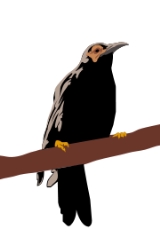
Crow Honeyeater
Encyclopedia
The Crow Honeyeater is a very large honeyeater
with orange facial wattles. It superficially resembles a crow
with its glossy black plumage. Crow Honeyeaters have long rounded wings and a long tail and neck. Their bill is long and bicolored- yellow below, black above. It has a loud, ringing sound.
This bird is endemic
to New Caledonia
and lives in humid forests on hills. It is relatively inconspicuous, and lives either in pairs or alone. It forages for invertebrates and nectar in the canopy and midstorey.
This bird is critically endangered
due to introduced rats. It is spread throughout the island, though mostly in the south. It is estimated that there are between 50 and 250 birds left.
Honeyeater
The honeyeaters are a large and diverse family of small to medium sized birds most common in Australia and New Guinea, but also found in New Zealand, the Pacific islands as far east as Samoa and Tonga, and the islands to the north and west of New Guinea known as Wallacea...
with orange facial wattles. It superficially resembles a crow
Crow
Crows form the genus Corvus in the family Corvidae. Ranging in size from the relatively small pigeon-size jackdaws to the Common Raven of the Holarctic region and Thick-billed Raven of the highlands of Ethiopia, the 40 or so members of this genus occur on all temperate continents and several...
with its glossy black plumage. Crow Honeyeaters have long rounded wings and a long tail and neck. Their bill is long and bicolored- yellow below, black above. It has a loud, ringing sound.
This bird is endemic
Endemism in birds
An endemic bird area is a region of the world that contains two or more restricted-range species, while a "secondary area" contains one or more restricted-range species. Both terms were devised by Birdlife International....
to New Caledonia
New Caledonia
New Caledonia is a special collectivity of France located in the southwest Pacific Ocean, east of Australia and about from Metropolitan France. The archipelago, part of the Melanesia subregion, includes the main island of Grande Terre, the Loyalty Islands, the Belep archipelago, the Isle of...
and lives in humid forests on hills. It is relatively inconspicuous, and lives either in pairs or alone. It forages for invertebrates and nectar in the canopy and midstorey.
This bird is critically endangered
Critically endangered
Version 2010.3 of the IUCN Red List of Threatened Species identified 3744 Critically Endangered species, subspecies and varieties, stocks and subpopulations.Critically Endangered by kingdom:*1993 Animalia*2 Fungi*1745 Plantae*4 Protista-References:...
due to introduced rats. It is spread throughout the island, though mostly in the south. It is estimated that there are between 50 and 250 birds left.

